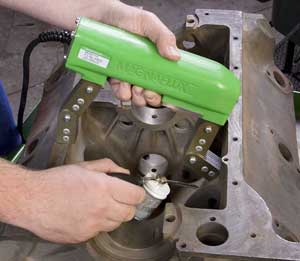If your customer wants you to diagnose a problem with a cylinder head or block, you’ll probably want to use one or more methods of crack detection to determine where the problems are. 
Dry Method Magnetic Particle Inspection
When "Magnafluxing" a casting, never blast with media prior to testing. Blast media peens the surface and can move metal, possibly closing the very cracks or flaws that you are trying to identify. When very coarse wire brushes are used roughly, they can also mask these areas.
Usually the casting itself, without cleaning, is the best indication of leakage. Check the casting by visually examining its entire surface to see if there is an area that looks exceptionally clean. Usually one or two combustion chambers or piston tops are free of carbon. Leaking coolant in an operating engine is an excellent carbon remover.
In diesel chambers, look for pitting on the casting or piston top. If we are in an area that has oil, but no combustion (such as the lifter or rocker arm area) look for anti-freeze "jelly". This is the result of coolant weeping into hot oil. A cracked area with poor-quality coolant or even just water in the system, would usually show rust along the crack.
Remember – these tips are not methods of crack detection, they are simply quick checks to speed up crack identification.
To help identify cracks quickly and easily while "Magnafluxing," choose a colored powder that stands out the most. For example, darker colors on bright parts and lighter colors (white or yellow) on dark castings.
For instance, Goodson’s Magnaflux powders are almost twice as "active" as other private label powders. In other words, using the same amount of powder and light source, you’ll find almost twice the amount of Goodson Magnaflux powder collected at the crack instead of laying about on the casting.
Alumni-Chek Method
When using this method, you need to chemically clean the area to be tested with Goodson’s AC-1 Cleaner (or equivalent cleaner), then dry the area. When AC-2 Penetrant is applied, let it stand for 2-3 minutes to penetrate into any cracks or flaws. Now the tricky part…removing the excess dye. Do not flood the entire area with chemical cleaner or water. Do not dry with compressed air. Use a damp shop towel (be sure to wring it out well) or a shop towel with just a light spray of cleaner applied to it, not the casting. Cleaning excess dye with this method will leave the dye in the flaws for the last step. AC-3 Developer can now be applied. This fluid will lift the dye from the casting and present it on a contrasting white background.
Leak Detection Plates
When using pressure or vacuum plates, give them a light coating of automatic transmission fluid. This cleans and seals for a better test. When testing is complete, apply another coat of ATF to clean and store the plates. This will keep them soft by helping to prevent oxidation.
– Tech Tip courtesy of Goodson.













